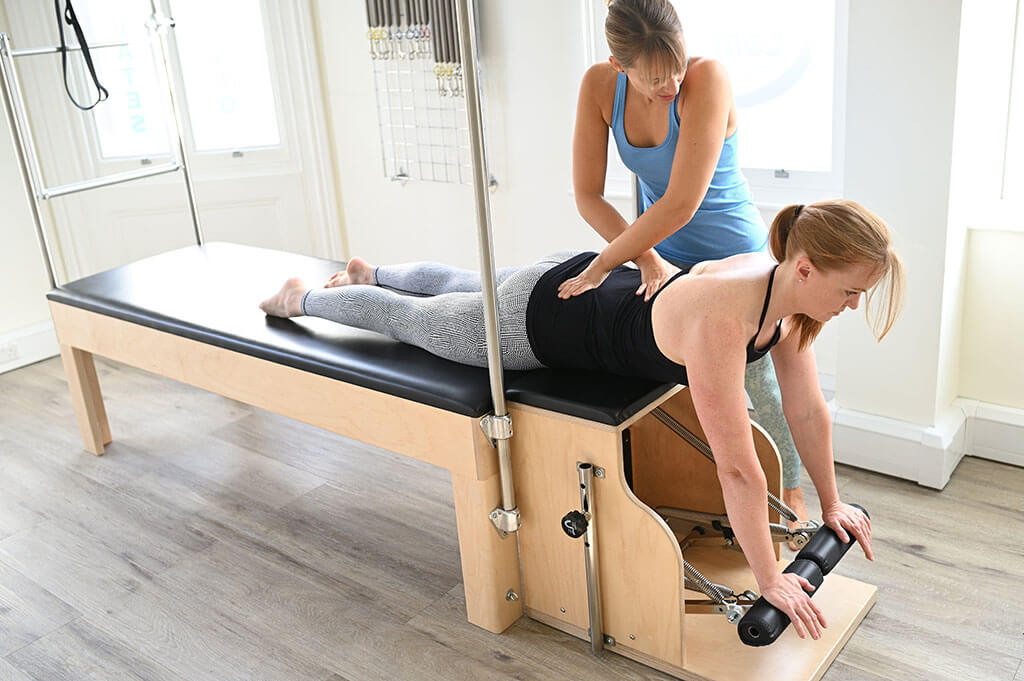Pelvic health physiotherapists treat a range of conditions around the pelvis for both women and men.
It is often just described as women’s health, as women are at much higher risk of the kind of conditions treated. Also, not all women’s health physios treat men. However, men can still suffer from complaints relating to their pelvic floor!
This is a less well known speciality within physiotherapy and often deals with complaints that are not openly discussed, or there is embarrassment around. This is despite there being a lot of people who have the same problems as you!
As a physiotherapy Pilates company, we see a lot of patients who are referred by women’s health physios, or who we refer on to a women’s health physio.
We want to explain exactly what a women’s health physiotherapist does, and how they could help you.
Enter Clare Pacey. We chatted with her about a physio’s role in women’s and men’s health and what kind of complaints she sees in her clinics.
The kind of complaints that a women’s health Physio may deal with can include;
- Bladder complaints
- stress incontinenc
- urge incontinence
- Bowel conditions
- severe constipation
- incontinence
- Pelvic organ prolapse (when pelvic organs such as bladder, bowel or uterus drop due to weakness in the pelvic floor)
- Post-natal rehab (of the whole body as well as the pelvic floor muscles)
- Diastasis recti (a gap between the abdominal muscles often seen during and after pregnancy)
- Pelvic girdle pain (of any sort including during and after pregnancy)
- back pain in pregnancy
- pain with sex (for men or women)
- coccyx pain (for men or women)
You can listen to the full interview in the video above. Or, we have summarised it below.
- Ladies during pregnancy: this can be for a number of reasons not just pain. We advise all pregnant ladies to have a check-up with a women’s health physiotherapist. This is so that we can see what is happening to your body and try and prevent any problems occurring.
- Ladies post-partum: It is important to be assessed properly for your pelvic floor and abdominal rehabilitation as well as your whole-body recovery after pregnancy and giving birth. In this way, your rehabilitation can be specific to you and your body.
- People with any pain around their pelvis: This can be anyone of any age! You may also be seeing a musculoskeletal physiotherapist at the same time.
- People with coccyx pain: Again, this can be anyone who may also have already had other treatment before coming to see a pelvic health physio.
- Referrals from a ‘normal’ physio: Orthopaedic surgeons will often refer straight to a ‘normal’ physio even though it may be a pelvic health complaint.
- Male patients with coccyx pain: This is a common reason for men to come to the pelvic health physio. In some cases, there can be a fairly quick fix!
Seeing a women’s health physio can feel daunting as it is often an area that we don’t like to talk to people about.
A women’s health physiotherapist is used to dealing with these problems and will carefully guide you through the assessment.
It will start with questions about what your problem is, and what your goals are so that they know why you are seeing us.
This will be followed by specific questions about your bladder, bowel and sexual health, what kind of exercise you do, and what kind of treatment you have already had.
We would then want to look at your posture, alignment and movement patterns. This can often indicate what is happening with the muscles around the pelvis.
The abdominal muscles are also often checked along with the core system as a whole.
It will often involve an internal assessment of the pelvic floor.
This means inside your vagina as a woman. This is the only way we can feel the pelvic floor muscles and see what is happening, particularly with a prolapse.
This can also be done in standing to see what happens with gravity.
Internal assessments are not compulsory and we can still treat without it. However, it is recommended as it allows for a full and thorough assessment whilst giving a lot of information about what is happening with your pelvic floor.
The kind of treatment offered varies greatly depending on you.
Everyone is individually assessed and considered for their own treatment plan specific to their needs.
We regularly get people who go to the GP saying they have done pelvic floor training.
However, women’s health physio offers a lot more than just the simple Kegel exercise squeezes.
The pelvic floor is like any muscle. It is important to train it to move through its full range of movement and be very precise.
This means going further than just the basic pelvic floor squeezes.
It includes training it for the demands you put through it. For example, runners need to train for more impact rather than just squeezes in sitting.
The pelvic floor also needs to be coordinated. Coordinating with the whole musculoskeletal system so that the body works in a balanced way.
Treatment can also include internal release and ‘down training’ which can then be self-administered. Breathwork can also help relax the pelvic floor, or help you to get an effective contraction.
The aim is to get you back to the things you currently find challenging!
This might be lifting, impact exercise, walking or running. Whatever the problem, the treatment has to be specific to you and your goals.
In short, yes!
Quite often you may be rehabbed together with a musculoskeletal physio and women’s health physio. This is because there is often a pelvic floor component to back pain, pelvic pain and hip pain.
There can be a complete disconnect to the pelvic floor as we are not always aware of how those muscles contribute to the function of the pelvis, hips and back.
You are likely to get a better result when we work together as a team.
Like in so many areas of healthcare, prevention is key!
We need to take this area of medicine seriously, particularly as a woman! In general, women are at a much higher risk of problems with our pelvic floor.
Ideally, you should have a consultation with a women’s health physio before any issues arise.
Learn good habits and getting good movement patterns will prevent future problems.
You also need a balanced core system to prevent future problems with your pelvis.
How do I become a women’s health physio?
Working in a department within the NHS is a great place to learn. You get support from a big team and see lots of different people.
Seek out specific physio courses if you are working privately. However, if you are solo, find a team that you can link to help your development.
Get involved with special interest networks in your area and use the opportunities for regular training.
It is a very good idea to have someone who can be a mentor to bounce ideas off.
If you have any further questions regarding women’s health as a woman or a man, please do get in touch with us here at Complete Pilates. We have a team of specialist physio and clinical Pilates instructors, who work closely with women’s health physios to deliver a team approach to physiotherapy and Pilates, whatever your pelvic health problem.
Education is key:
These blogs are designed to give information to everyone, however, it is important to remember that everyone is different! If you have not seen one of our therapists and have any questions about injuries, what you have read or whether this may be useful to you, please just ask. We are more than happy to help anyone and point you in the right direction. Our biggest belief is that education is key. The more you understand about your injury, illness and movement, the more you are likely to improve.




